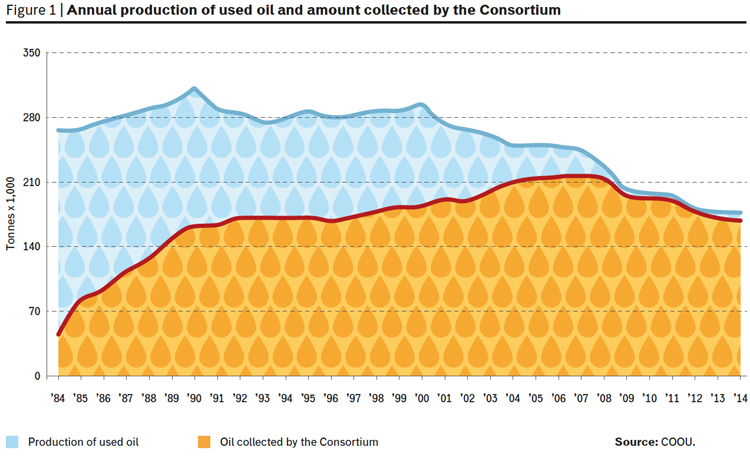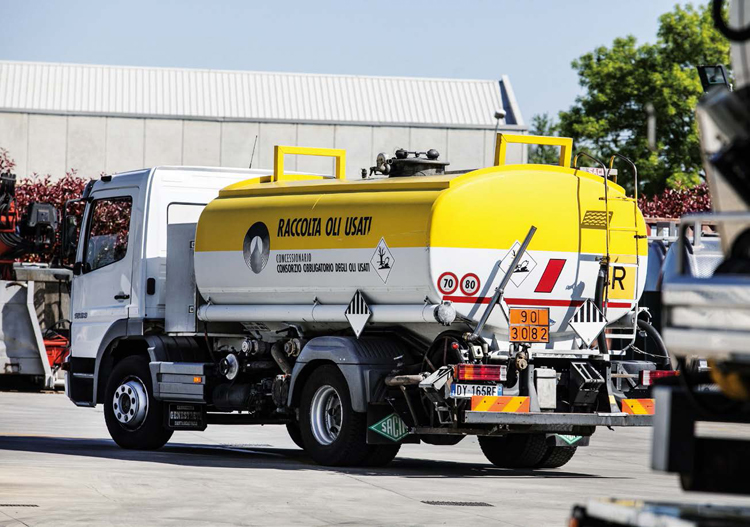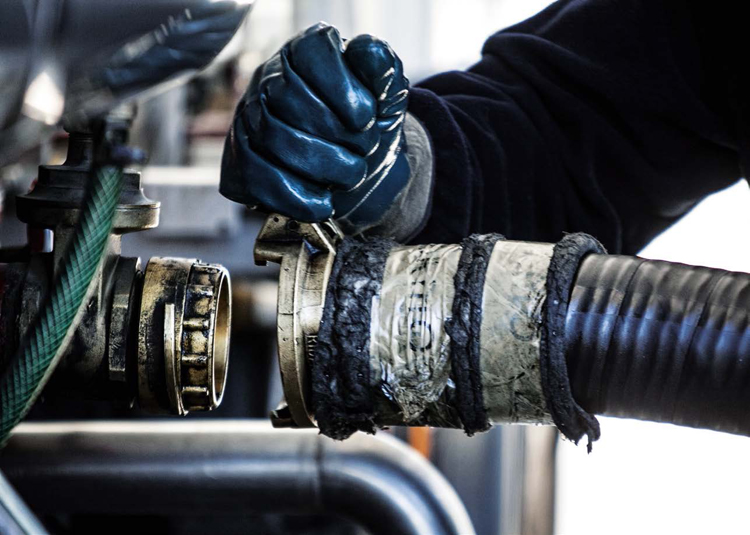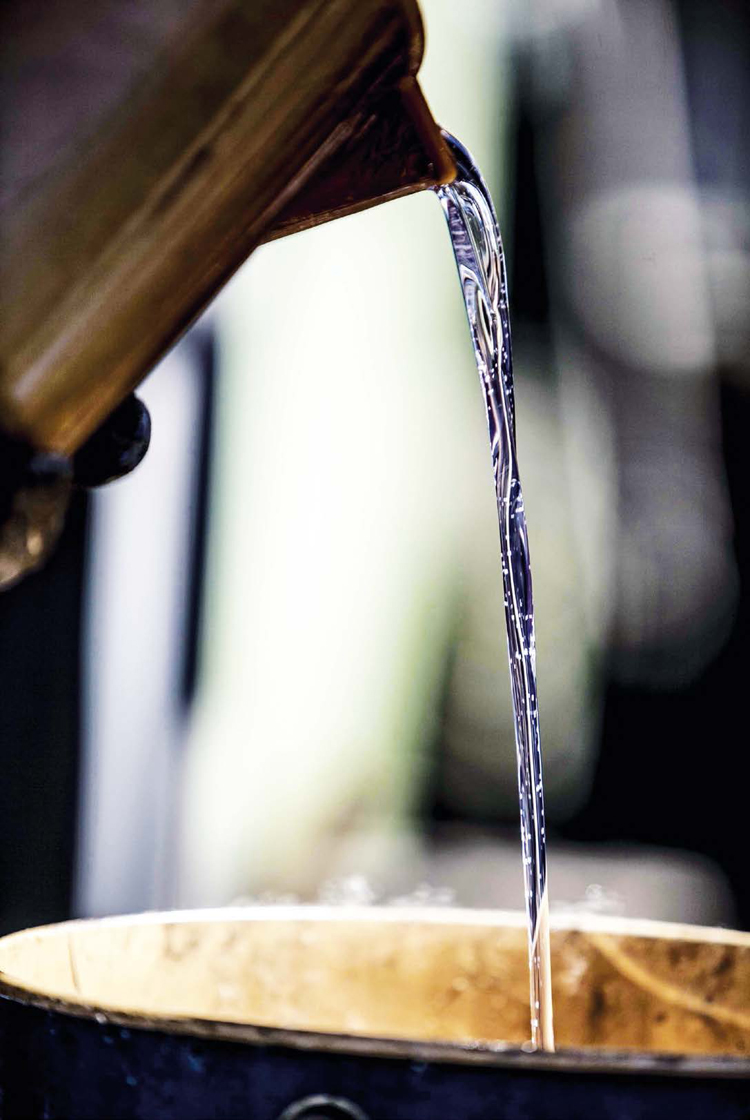Since its creation over 30 years ago, one of the Italian Mandatory Consortium for Used Oils’ assets has been the choice of its legal structure. The COOU has a private-law corporate structure, binding all major players in the lubricant industry: from large oil companies to the businesses regenerating used oils and trading lubricants. The Consortium is publicly controlled by the Italian Ministries of the Environment, the Economic Development, the Economy and Finance and Health, each having its own representatives in the Board of Directors.
It is a setup where competences, compulsoriness, and non-profit purpose, combined with a mandatory, sound, transparent management at an economic and industrial level, have been able to create an effective synergy, successful in achieving the objectives defined by law.
Since the beginning, the COOU has been granted extensive competences, such as guaranteeing oil collection even in unfavourable market conditions, or monitoring and reporting the overall national performance to the supervisory authorities. In addition, the Consortium is in charge of spreading information and awareness regarding environmental issues among citizens and operators. The collection of used lubricants aims not only at preventing them from damaging the environment, but also at bringing them back into the economic, industrial and consumer cycle in the most advantageous way for the national community. Basically, it consists in collecting as much oil as possible, recycling and reusing it through the most cost-effective processes and minimizing the amounts and types of polluting residues by disposing of them safely and in full compliance with all regulations.
The environmental performance of the Consortium can be clearly seen in figure 1, where a comparison is made between the numbers regarding the used oil allegedly produced in Italy and the actual amount collected from 1984 to 2008.

A few numbers: over the last thirty years of activity, 5.238 million tonnes of used oil have been collected and completely recycled. By regenerating this quantity, 4.341 million tonnes have been turned into lubricant or gas oil and bitumen (83% in 30 years, 91% in the last 10 years), 0.565 million tonnes have replaced fuel and coal for combustion, and 0.028 million tonnes of irreparably polluted oil have been incinerated.
The regeneration has produced 2.592 million tonnes of base oils, used in the formulation of 27% of the lubricant oils used in Italy. According to 2014 figures, collection, treatment and reuse of used oil have saved Italy approximately €3 billion on petroleum products imports.
However, the other – and more important – side of the coin is the sustainability of our path, as proved by lower CO2 emissions and reduced consumption of water, matter and soil. In particular, there have been total savings of 2.3 billion cubic metres of water, 6.4 million tonnes of virgin raw materials, 1.1 million tonnes of CO2 equivalent climate-changing emissions and, lastly, 7,306 hectares of land that kept their original use.

Knowing When it is Time to Change
Most of these achievements are not the result of the circumstances or luck, but of the key strategy to conceive the Consortium as a flexible structure able to face change when necessary. Since I was appointed Chairman in 2003, the COOU has strengthened its support to the supply chain by making available its experience and skills to the sector’s businesses in order to carry out – in a joint effort – the metamorphosis required by the industry and market changes. In those years, our industry was also being affected by the big change characterizing the waste management at the beginning of the third millennium. Many material flows were beginning to have attractive characteristics and qualities for the market and some of them were worth more than the cost of their collection, which determined a series of important changes within the waste economy. After years of stability, the substantial changes affecting the regulatory profiles, market organization and structure of this sector’s businesses were such as to alter the scenario dramatically.
Consequently, a strategic redeployment and a reformulation of the operational structure of the Consortium were necessary. If on the one hand the stress was on the organizational inefficiencies determined by the high costs, operating time of collection and storage of used oil, on the other, there was room for the Consortium to improve the fulfilment of its institutional task. In order to do this, the most radical, and yet safest way, was chosen: rethinking all activities by undertaking a BPR study (Business Process Reengineering). The old modus operandi and choices were challenged, aiming at rethinking the Consortium’s structure in a way more suitable to meet the needs of a rapidly evolving environment. Therefore, the sector targets and communication policy were revised and the necessary structural changes (staff, organization, and IT system) were examined.

2009: A Turning Point
In September 2009, the Decree Law 135/2009 was promulgated to redress the European Commission’s remarks on Italy – including the subsidized excise duty on energy products obtained through the regeneration of used oils. the Decree considerably increased the Consortium’s competences. Besides standardizing the excise duty on all lubricant, virgin or regenerated oils to €750 per tonne, the Decree reiterated the obligation of the Consortium to regenerate all oils suitable for this purpose – by paying refineries for the processing, an unprecedented event – and to combust all used oil which cannot be regenerated.
The reference framework underwent a second important change because of the drastic drop in the consumption of lubricants, converted into used oils at the end of their life cycle. Since 2000, the consumption of lubricants has decreased by 40% (260,000 tonnes less). Far from being marginal, this fact is shocking because it is related to a structural phenomenon rather than the current economic situation. Consequently, it has been necessary to rethink the overall context by speeding up the rationalization of the supply chain, thus giving businesses new competitiveness in a market opened to foreign operators. In fact, the scenario has been complicated by the latter’s interest in the Italian used oil. The Consortium has faced the new challenge of distributing the collection of used oil for regeneration among non-Italian operators too. This has disturbed the uneasy balance achieved by the supply chain and jeopardized the important environmental and economic results achieved. The oil collection, already declining sharply, would not be sufficient to keep the economic balance of Italian refineries.
The Italian Ministry of the Environment was asked to interpret the provisions of the European directive on the matter. As a response, the Circular 0023876 dated 26th March 2013 GAB was issued, where the environmental appropriateness of blocking the exports of Italian used oil was analyzed in detail. But more importantly, the Circular went beyond the targets of environmental protection by offering businesses of the used oil supply chain enough technical time to rethink their future, i.e. to reorganize themselves in size, in macro rather than micro terms. Unfortunately, not all businesses immediately understood how far-reaching this change was: skills and experience were no longer enough and it was also necessary to deal with globalization.
But there is a third and equally important issue to tackle, namely that the Consortium, which is basically handling all Italian used oil, could be a market distortion factor. Indeed, with its dominant position, it has to distribute used oil among all requesting companies, binding them to collect amounts of used oil, which are not only fixed, but also decreasing because of the sharp decline of the Italian lubricant market. Therefore, in this complex situation, not only has the “used oil supply chain” changed its operational profile, but also all the economic balances related to it.

The system, unchanged for many years, seems about to enter troubled waters. The COOU started to think that, under certain conditions, it could stop being the only buyer of the used oil collected in Italy. The analysis of the guidelines confirms that the role of the Consortium is guaranteeing and boosting collection, by encouraging the transition to freedom of contract among the operators of collection and regeneration and helping buying and selling used oils at the same time. In order for the system to remain balanced in any condition, the Consortium committed itself to intervening in a subsidiary way in case of market failure to ensure the universal service entrusted to it by the law. With this new model, it is up to the market to decide when it is necessary for the Consortium to play its subsidiary role in the collection and regeneration processes. However, it is possible to predict variations well in advance. Therefore, the Consortium modified its management structure. With the growing market freedom, regenerators slowly started competing for used oil, which was no longer equally distributed among all requesting operators. When imposed by the existing economic circumstances, collection will be assured by a buyer of last resort.
In November 2014, the hearing in the Italian Senate of Professor Pitruzzella, president of the Italian Antitrust Authority (AGCM), confirmed that the right choice had been made. “... a possible solution, balancing the needs to respect the competitive principles and comply with public service obligations, could result from the reorganization of the consortium system towards a last resort model. Eventually, this seems to be happening in the used oil market. Here, there has been a change from the Mandatory Consortium model – taking oil from collector businesses to guarantee its regeneration – to a system where the direct contact between collecting businesses and regeneration facilities prevails. Here, the Consortium acts as a ‘last resort intermediary,’ meaning it intervenes only when the market cannot self-regulate...”
Italian Antitrust Authority, www.agcm.it.
Info



